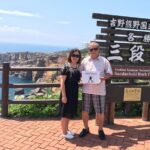Mibu-Dainenbutsu Kyogen, a captivating and unique tradition, has been enchanting audiences for over seven centuries at Mibu-dera Temple in Kyoto.
Designated as an important intangible folk cultural asset, this tradition uses pantomime to depict Buddhist morality tales.

Known for its silent performances and instrumental sounds, Mibu-Dainenbutsu Kyogen portrays glimpses from Buddhist parables and Japanese folktales.
With colorfully-costumed actors and weathered masks, this tradition is a cornerstone of Kyoto culture, offering both recreational programs and teachings on karma, morality, and spiritual verities.
Key Takeaways
- Mibu-Dainenbutsu Kyogen is a silent performance that uses instrumental sounds to communicate Buddhist precepts.
- It is a cornerstone of Kyoto culture, combining religious essence with recreational programs.
- The performances impart teachings on karma, morality, and spiritual verities.
- Key performances include Oketori, Atagomairi, and Kechiganshiki.
The Origins of Mibu-Dainenbutsu Kyogen
The origins of Mibu-Dainenbutsu Kyogen can be traced back to the early 14th Century when it originated from the offerings of Saint Engaku and utilized pantomime to depict Buddhist morality tales. This captivating form of theater has been a unique feature of Mibu-dera Temple, located in Kyoto, for over seven centuries.
Mibu Kyogen, as it was originally known, evolved into the present-day Kyogen and continues to artfully explain Buddhist teachings. The performances portray glimpses from Buddhist parables and Japanese folktales, using classic scenery items like bells, flutes, and drums. Colorfully-costumed actors don weathered masks, and their thrilling stage interactions add an element of surprise to the audience’s experience.
These performances occur during Setsubun, spring, and autumn seasons, making them one of the most awaited events in Kyoto, especially in February.
The Significance of Mibu-Dera Temple in Kyoto Culture
Located in Kyoto, Mibu-dera Temple holds great significance in the cultural heritage of the city. This historic temple, founded in the early 14th century, is renowned for its enchanting silent tradition called Mibu-Dainenbutsu Kyogen. Through this unique form of performance, Mibu-dera Temple artfully explains Buddhist teachings while captivating audiences for over seven centuries. The temple’s commitment to preserving this cultural treasure is evidenced by Mibu Kyogen being designated as an important intangible folk culture asset.
To further understand the significance of Mibu-dera Temple in Kyoto’s cultural landscape, let’s explore the table below:
| Key Points | Significance |
|---|---|
| Historic Temple | Mibu-dera Temple is a testament to Kyoto’s rich history. |
| Cultural Heritage | It showcases the city’s deep-rooted traditions. |
| Preservation of Tradition | Mibu Kyogen has been performed for over 700 years. |
| Buddhist Teachings | The performances artfully depict Buddhist morality tales. |
| Community Engagement | Mibu-dera Temple offers unique customs to enrich visits. |
Mibu-dera Temple not only serves as a spiritual sanctuary but also as a hub for cultural exchange and engagement. Its rich history, dedication to preserving ancient traditions, and commitment to community interaction make it a must-visit destination for anyone interested in experiencing the vibrant cultural heritage of Kyoto.
The Unique Performance Variants of Mibu-Dainenbutsu Kyogen
Using classic scenery items like bells, flutes, and drums, the colorfully-costumed actors don weathered masks to portray glimpses from Buddhist parables and Japanese folktales during the performances. This unique variant of Mibu Kyogen captivates the audience with its enchanting silent tradition.
Here are four emotional responses evoked by the performances:
- Awe: The combination of intricate costumes, skillful acting, and traditional instruments creates a mesmerizing atmosphere that leaves the audience in awe.
- Wonder: The stories depicted in the performances offer a glimpse into ancient Japanese culture, sparking a sense of wonder and intrigue.
- Amusement: The thrilling stage interactions and comedic elements of the performances bring laughter and amusement to the audience.
- Spiritual Connection: The underlying Buddhist teachings and moral lessons conveyed through the pantomime and instrumental sounds foster a deep spiritual connection with the audience.
These emotional responses make Mibu-Dainenbutsu Kyogen a truly unforgettable experience for all who witness it.
The Spiritual Teachings Conveyed Through Mibu-Dainenbutsu Kyogen
Portraying Buddhist teachings through pantomime and instrumental sounds, Mibu-Dainenbutsu Kyogen imparts spiritual wisdom and moral lessons to its audience. This unique form of silent performance utilizes the power of visuals and music to communicate profound teachings on karma, morality, and spiritual truths.
The captivating performances of Mibu-Dainenbutsu Kyogen, such as Oketori and Atagomairi, offer a blend of entertainment and religious essence. Through the use of pantomime and instrumentals, the actors skillfully convey the essence of Buddhist precepts, allowing the audience to reflect and contemplate on the teachings being shared.
This enriching experience not only entertains but also serves as a source of enlightenment and guidance. Mibu-Dainenbutsu Kyogen is a cherished tradition that continues to captivate and inspire audiences, offering a unique and meaningful way to engage with Buddhist teachings.
The Captivating Performances: Oketori and Atagomairi
The captivating performances of Oketori and Atagomairi showcase the rich blend of entertainment and religious essence found in Mibu-Dainenbutsu Kyogen. These traditional Japanese plays, performed at Mibu-dera Temple in Kyoto, have been captivating audiences for over seven centuries.
Oketori: This performance depicts the story of a monk who visits a wealthy family and is mistaken for a thief. The comedic interactions between the monk and the family members create a humorous and engaging experience for the audience.
Atagomairi: In this performance, a demon is exorcised from a possessed person through the power of Buddhist teachings. The intense energy and dramatic movements of the actors leave the audience spellbound.
Through these performances, Mibu-Dainenbutsu Kyogen not only entertains but also imparts valuable teachings on karma, morality, and spiritual verities. It is a unique cultural experience that combines art, religion, and entertainment, making it a must-see event in Kyoto.
The Enriching Community Interaction During Mibu-Dainenbutsu Kyogen
During the performances of Mibu-Dainenbutsu Kyogen, the community participates in fascinating customs that enhance their cultural experience. These unique practices add an interactive element to the silent performances, making it a truly immersive event.
One of the customs involves catching a spider’s thread for good fortune. It is believed that if you are able to catch the thread, it brings luck and blessings upon you.
Another custom is the purchase of Horaku rice crackers, which is associated with religious faith. These rice crackers are considered to be a symbol of good luck and are often bought as souvenirs during the performances.
The Fascinating Customs and Rituals Associated With Mibu-Dainenbutsu Kyogen
Engaging in these customs and rituals associated with Mibu-Dainenbutsu Kyogen allows the community to immerse themselves in the rich traditions and heritage of this captivating event. The fascinating practices during the performances add an extra layer of excitement and meaning to the experience.
Here are some of the customs that make Mibu-Dainenbutsu Kyogen truly unique:
- Catching a spider’s thread for good fortune: It is believed that finding and catching a spider’s thread brings good luck and blessings to the person who catches it.
- Purchase of Horaku rice crackers associated with religious faith: Horaku rice crackers are considered special and are often purchased during Mibu-Dainenbutsu Kyogen as a way to show devotion and support for the event.
- Mibu Kyogen recognized as Kyoto’s first designated Important Intangible Folk Cultural Property: This designation highlights the cultural significance and value of Mibu Kyogen in preserving and promoting Kyoto’s cultural heritage.
- Mibu-dera offers facilities enhancing visitor experience: The temple provides various amenities and facilities to enhance the visitor experience, allowing them to fully immerse themselves in the traditions and rituals of Mibu-Dainenbutsu Kyogen.
The Recognition of Mibu Kyogen as an Important Intangible Folk Cultural Property
Recognized as Kyoto’s first designated Important Intangible Folk Cultural Property, Mibu Kyogen holds immense cultural significance in preserving and promoting the city’s heritage.
This traditional form of theater has captivated audiences for centuries with its artful portrayal of Buddhist teachings. Originating from the offerings of Saint Engaku in the early 14th century, Mibu Kyogen has evolved into a unique feature of Mibu-dera Temple.
Using pantomime and colorful costumes, the performances depict glimpses from Buddhist parables and Japanese folktales. Bells, flutes, and drums are used as classic scenery items, adding to the immersive experience.
Mibu Kyogen is eagerly awaited by locals and visitors alike during the Setsubun, spring, and autumn seasons. Its recognition as an Important Intangible Folk Cultural Property further enhances its value and ensures its preservation for future generations to appreciate and enjoy.
Enhancing the Visitor Experience at Mibu-Dera Temple
Visitors to Mibu-dera Temple can enhance their experience by exploring the various facilities and amenities offered.
The temple, located in Kyoto and founded in the early 14th century, is renowned for its unique Mibu Kyogen performances. These captivating shows, designated as important intangible folk culture assets, have been delighting audiences for over seven centuries.
Using pantomime to depict Buddhist teachings, the actors skillfully bring to life glimpses from Buddhist parables and Japanese folktales. The performances, accompanied by classic scenery items like bells, flutes, and drums, feature colorfully-costumed actors donning weathered masks. With thrilling stage interactions that add an element of surprise, these shows are eagerly awaited by locals and tourists alike.
Mibu-dera Temple also offers facilities that enrich the visitor experience, making it a must-visit destination for those seeking to immerse themselves in the rich cultural heritage of Kyoto.
Frequently Asked Questions
How Can Audience Members Interact With the Performers During Mibu-Dainenbutsu Kyogen?
Audience members can interact with performers during Mibu-Dainenbutsu Kyogen by participating in fascinating customs, such as catching a spider’s thread for good fortune and purchasing Horaku rice crackers. These practices enrich the experience and connect the community to the silent tradition.
What Are Some Unique Customs and Rituals Associated With Mibu-Dainenbutsu Kyogen?
Some unique customs and rituals associated with Mibu-Dainenbutsu Kyogen include catching a spider’s thread for good fortune and the purchase of Horaku rice crackers, which are linked to religious faith.
How Does Mibu Kyogen Contribute to Kyoto’s Cultural Heritage?
Mibu Kyogen captivates audiences in Kyoto for over seven centuries. It artfully explains Buddhist teachings through pantomime and has become a cornerstone of Kyoto’s cultural heritage.
Are There Any Specific Spiritual Teachings Conveyed Through Mibu-Dainenbutsu Kyogen?
Mibu-Dainenbutsu Kyogen conveys specific spiritual teachings. It uses silent performances and instrumental sounds to communicate Buddhist precepts, imparting lessons on karma, morality, and spiritual truths.
What Facilities Does Mibu-Dera Temple Offer to Enhance the Visitor Experience?
Mibu-dera Temple offers various facilities to enhance the visitor experience. These include informative exhibits on the history and significance of Mibu Kyogen, serene gardens for contemplation, and a gift shop with unique souvenirs.
Conclusion
In conclusion, Mibu-Dainenbutsu Kyogen is a captivating and enchanting tradition that has been captivating audiences for over seven centuries. This unique form of pantomime uses instrumental sounds to communicate Buddhist precepts and portrays glimpses from Buddhist parables and Japanese folktales.
Mibu-Dainenbutsu Kyogen not only retains religious essence but also offers recreational programs and imparts teachings on karma and morality. The tradition is a cornerstone of Kyoto culture and is recognized as an Important Intangible Folk Cultural Property.
Visitors to Mibu-dera Temple can enhance their experience by immersing themselves in this rich cultural tradition.





